
Omaha, commonly known as Omaha Beach, was the code name for one of the five sectors of the Allied invasion of German-occupied France in the Normandy landings on June 6, 1944, during World War II. "Omaha" refers to an 8-kilometer (5 mi) section of the coast of Normandy, France, facing the English Channel, from east of Sainte-Honorine-des-Pertes to west of Vierville-sur-Mer on the right bank of the Douve River estuary. Landings here were necessary to link the British landings to the east at Gold with the American landing to the west at Utah, thus providing a continuous lodgement on the Normandy coast of the Bay of the Seine. Taking Omaha was to be the responsibility of United States Army troops, with sea transport, mine sweeping, and a naval bombardment force provided predominantly by the United States Navy and Coast Guard, with contributions from the British, Canadian and Free French navies.
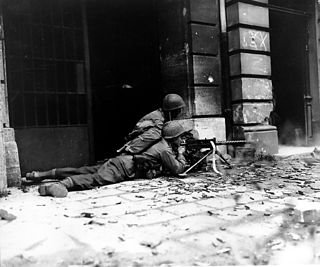
The Battle of Aachen was a combat action of World War II, fought by American and German forces in and around Aachen, Germany, between 2–21 October 1944. The city had been incorporated into the Siegfried Line, the main defensive network on Germany's western border; the Allies had hoped to capture it quickly and advance into the industrialized Ruhr Basin. Although most of Aachen's civilian population was evacuated before the battle began, much of the city was destroyed and both sides suffered heavy losses. It was one of the largest urban battles fought by U.S. forces in World War II, and the first city on German soil to be captured by the Allies. The battle ended with a German surrender, but their tenacious defense significantly disrupted Allied plans for the advance into Germany.
The 741st Tank Battalion was an independent tank battalion that participated in the European Theater of Operations with the United States Army in World War II. The battalion participated in combat operations throughout northern Europe until V-E Day. It was one of five tank battalions that landed in Normandy on D-Day. It landed on Omaha Beach supporting the 1st Infantry Division, but was attached to 2d Infantry Division on 15 June 1944, which it supported for most of the remainder of the war. The battalion played a key role in blunting the northern flank of the German attack during the Battle of the Bulge in December 1944. The 741st Tank Battalion advanced as far as Plzeň, Czechoslovakia by the end of the war.

The U.S. 60th Infantry Regiment is a regimental unit in the United States Army. Its 2nd and 3rd Battalion conduct Basic Combat Training.
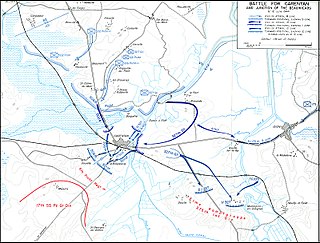
The Battle of Carentan was an engagement in World War II between airborne forces of the United States Army and the German Wehrmacht during the Battle of Normandy. The battle took place between 6 and 13 June 1944, on the approaches to and within the town of Carentan, France.
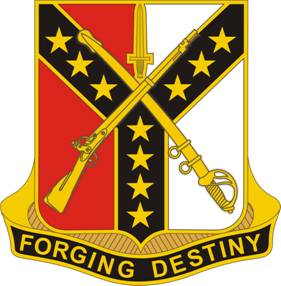
The 601st Tank Destroyer Battalion was a battalion of the United States Army active during World War II. It was the first of the newly formed tank destroyer battalions to see combat, and the only one to fight as a "pure" tank destroyer force. It also has the unusual distinction of being one of the few American units to fight in all three major campaigns against Nazi Germany and to have participated in four assault landings.

The 818th Tank Destroyer Battalion was a tank destroyer battalion of the United States Army active during World War II. It first saw combat in July 1944, when it deployed into the Normandy beachhead in preparation for the breakout into France by Lieutenant General George Patton's Third Army. Working closely with the 5th Infantry Division, it moved through northern France up to the Moselle region, where it was involved in the Battle for Metz through September, October and November. In December, it disengaged from defensive positions along the German border and was moved north to fight in the Battle of the Bulge with the 26th Infantry Division. After securing the Allied flanks and mopping up the Bulge, it refitted for two months before fighting south along the Siegfried Line and crossing the Rhine in March. In April and early May, it rushed through southern Germany into Austria and Czechoslovakia, where it ended the war. After a brief spell of occupation duties, it was returned to the United States and disbanded in November. During the European campaign, the battalion lost a total twenty-six men and eight tank destroyers in combat.
The 773rd Tank Destroyer Battalion was a tank destroyer battalion of the United States Army active during the Second World War.
The 628th Tank Destroyer Battalion was a tank destroyer battalion of the United States Army active during the Second World War. It was redesignated the 628th Tank Battalion after the end of the war, and today exists as the 103rd Armor Regiment.

The 643rd Tank Destroyer Battalion was a tank destroyer battalion of the United States Army active during the Second World War.
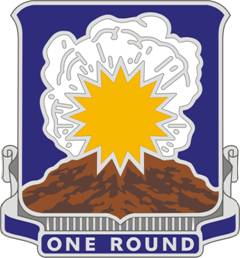
The 705th Tank Destroyer Battalion was a tank destroyer battalion of the United States Army active during the Second World War. It was originally formed from artillery elements of the 5th Armored Division, and its lineage is today perpetuated by the 75th Cavalry Regiment.
The 825th Tank Destroyer Battalion was a tank destroyer battalion of the United States Army active during the Second World War. It was organized as a towed battalion, with 3" anti-tank guns, and initially saw service during the Battle of Normandy as a rear-area security unit. Parts of the unit were sent into combat as part of an ad hoc task force on 16 December 1944, on the northern flank of the Ardennes Offensive, where it defended Amblève river bridges at Malmedy and Stavelot. It returned to security duties at the end of January 1945, and served in rear areas for the remainder of the war.

The 743rd Tank Battalion was an independent tank battalion that participated in the European Theater of Operations with the United States Army in World War II. It was one of five tank battalions which landed in Normandy on D-Day. The battalion participated in combat operations throughout northern Europe until V-E Day. It was inactivated on 27 November 1945.
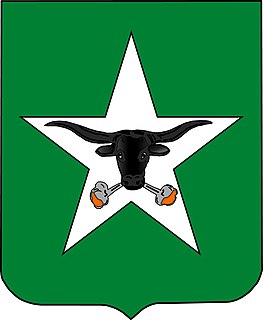
The 747th Tank Battalion was an independent tank battalion that participated in the European Theater of Operations with the United States Army in World War II. It was credited with an assault landing at Normandy, landing the morning after the initial D-Day landings (D+1). The battalion participated in combat operations throughout northern Europe until V-E Day, primarily attached to the 29th Infantry Division. After the war it was briefly engaged in occupation duties. Redesignated the 747th Amphibian Tank Battalion on 10 July 1945, it was inactivated in March 1946.
The 746th Tank Battalion was an independent tank battalion that participated in the European Theater of Operations with the United States Army in World War II. It was one of five tank battalions which landed in Normandy on D-Day. The battalion participated in combat operations throughout northern Europe until V-E Day. It served primarily as an attachment to the 9th Infantry Division, but fought alongside numerous other units as well. It was inactivated in October 1945.
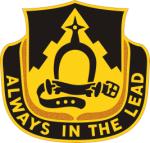
The 303rd Cavalry Regiment is a United States cavalry regiment, currently represented in the Washington Army National Guard by the 1st Squadron, 303rd Cavalry, headquartered at Vancouver, Washington, part of the 96th Troop Command. It incorporates the lineage of the 303rd Cavalry, 303rd Armor, and 803rd Armor Regiments of the Washington Army National Guard.
The 302nd Armored Cavalry Regiment was a New York-based reconnaissance unit of the United States Army Organized Reserve Corps, which briefly existed after World War II. Constituted in 1948, it was partially organized later that year and inactivated in 1950.
The 300th Armored Cavalry Regiment was a Texas-based reconnaissance unit of the United States Army Organized Reserve Corps, which briefly existed after World War II. It was constituted in 1948 and partially organized from existing units before being inactivated in 1950 and disbanded in 1952.
The 310th Armored Cavalry Regiment was a California-based reconnaissance unit of the United States Army Organized Reserve Corps, which briefly existed after World War II. It was constituted in 1948, partially organized from existing units in 1949, and inactivated in 1950.
Troop E,256th Cavalry was the armored cavalry reconnaissance troop of the 256th Infantry Brigade of the Louisiana Army National Guard from 1967 to 1995. It was the only unit assigned to the 256th Cavalry parent regiment under the Combat Arms Regimental System, which carried over to the replacement United States Army Regimental System.










